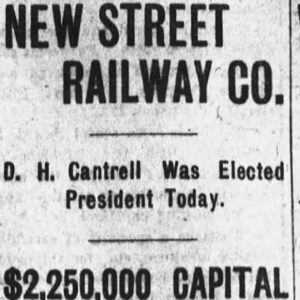calsfoundation@cals.org
Deaderick Harrell (D. H.) Cantrell (1868–1934)
Deaderick Harrell (D. H.) Cantrell was a Little Rock (Pulaski County) lawyer and prominent citizen in the late nineteenth and early twentieth centuries. Cantrell Road in Little Rock was named for him.
D. H. Cantrell was born on June 14, 1868, in Little Rock. The family home was at 619 Scott Street. Cantrell’s father was William Armour Cantrell, a prominent physician. His mother was Ellen Maria Harrell Cantrell, an accomplished writer and musician. He had seven siblings: Lillian, Ellen, Daisy, Wendel, Isadore, Bessie, and William. The Cantrells were prominent members of Christ Episcopal Church, and his mother wrote The Annals of Christ Church Parrish and was a frequent contributor to local newspapers and magazine publications.
D. H. Cantrell attended St. Johns’ College in Little Rock and graduated from William & Mary in Virginia. Cantrell then returned to Little Rock, where he “read law” in the office of John M. Moore and Judge Henry Clay Caldwell. Cantrell was admitted to the bar in 1889 without attending law school, a common practice at the time. He started a practice with Joseph W. House Sr. After a few years of practice, he became a law partner with J. F. Loughborough, an association that would last the rest of his life. Ten years later, Cantrell and Loughborough joined with Uriah Milton Rose and renamed the firm Rose, Hemmingway, Cantrell, Loughborough and Miller. The firm later came to be known simply as the Rose Law Firm.
Cantrell married Catherine Emrich in 1918. He was fifty years old and she nineteen. They had no children. They moved to a house at 2418 N. Spruce, a house that no longer exists.
Cantrell was a successful lawyer and was known as one of the best trial and courtroom attorneys in the state. His obituary credits him as being president at various times of the Little Rock Street and Electric Company, Country Club of Little Rock, Little Rock Athletic Association, Quapaw Club, and Little Rock Bar Association.
The area of Pulaski Heights was incorporated as a town in 1905. Soon, it was absorbed by the City of Little Rock. One of the first structures built was the Country Club of Little Rock. Cantrell, an affluent and respected citizen, joined and eventually became president. The usual method accessing the country club from downtown at that time was by streetcar, which was permitted by the laying of tracks along Markham Street, Third Street, and Kavanaugh Boulevard (originally Prospect). Passengers would debark at Country Club Station, near the intersection of what is now Cantrell Road and Kavanaugh Boulevard, and would either walk or ride in a buggy to the country club. One could also drive there if one owned an automobile, a rare thing then. Soon, Prospect was crowded with wagons, streetcars, bicycles, and automobiles.
Cantrell found that there existed a narrow dirt road leading to the country club. It came off the River Road (now Rebsamen Park Road) in what is now the Riverdale area. Remnants of this dirt road can still be seen, and the road roughly parallels present-day Sherrill Road. Because the dirt road was narrow, muddy, and frequently washed out. Cantrell envisioned a new road heading west and ascending the hilltop of Pulaski Heights, near what is now Allsopp Park. Eventually, he conferred with County Judge Charles Moyer.
A decision was made to establish the road, and several investors joined in the project, including the Country Club of Little Rock, Pulaski Heights Land Company, Southern Trust Company, and Ben McGhee. The work started in 1930 and finished in 1931. Many tons of rock and dirt were removed. Drivers could leave Little Rock, cross the Lincoln Avenue Viaduct, proceed down Lincoln Avenue, and continue down the River Road, but instead of continuing on the River Road (present-day Rebsamen Park Road), they would make a ninety-degree turn and go up the hill to Pulaski Heights. The new road was a great success. In 1930, the Little Rock City Council voted to name the road Robinson Drive in honor of Senator Joseph Taylor Robinson. The senator graciously declined the honor and requested the road bear the name of Cantrell. It has been called Cantrell Road ever since and also bears the designation of State Highway 10.
Cantrell died on April 4, 1934, in Washington DC, where he had traveled on business. He was staying with his nephew, William G. Gooden, and probably died of heart disease. He is buried in Mount Holly Cemetery in Little Rock, as is his wife, who died in 1984.
For additional information:
“Cantrell Hill Residents Needed Paved Road, But Not the Traffic.” Arkansas Gazette, March 14, 1976, p. 5A.
Clark, Richard B., and Michael J. Hood. “Remembering Deaderick Harrell Cantrell in the Construction of Cantrell Road.” Pulaski County Historical Review 68 (Summer 2020): 37–44.
“D. H. Cantrell Dies in Washington, D.C.” Arkansas Gazette, April 5, 1934, p. 10.
Richard Barnes Clark
Little Rock, Arkansas
 Early Twentieth Century, 1901 through 1940
Early Twentieth Century, 1901 through 1940 Law
Law New Street Railway Company Story
New Street Railway Company Story 




Comments
No comments on this entry yet.